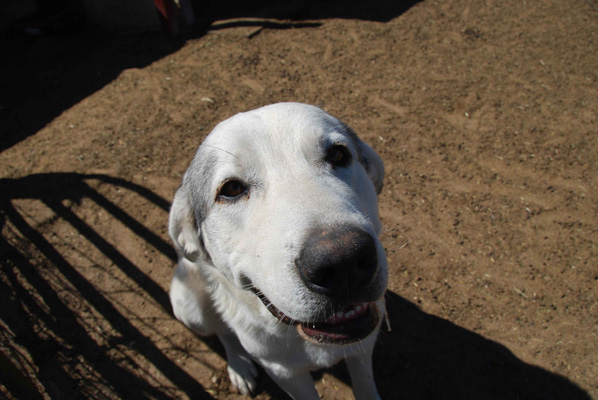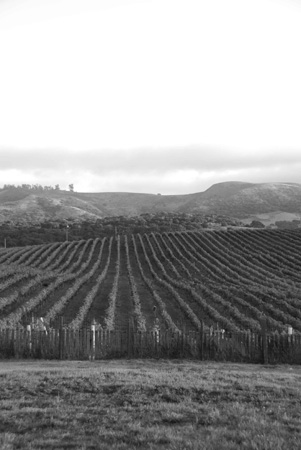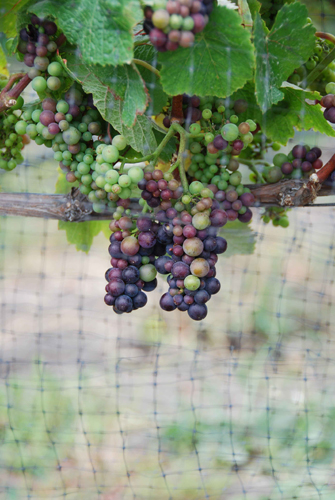(Another) Year in the Vineyard Blog
With Wes Hagen, VM/WM Clos Pepe
Week #27: September 10-16
Loving the Weather, Testing the Grapes, Time for a Cocktail!
To be honest, I can’t remember being so calm in the 3rd week of September. Traditionally by this date we’ve already harvested two or three nights/mornings and have at least a fermenter cold-soaking at the winery. But as many of you Californians are aware, and anyone else that’s been paying attention to the Blog, we have had an extraordinarily cool, consistent growing season. The berries are tiny, the crop is moderate (not small or big), the Brix is creeping up around a single digit per week, and the acidity is still quite high. A few of the winemakers that are noted for their restrained style and lower alcohol, including myself, are looking at next week very seriously for bringing in our first Clos Pepe pinot fruit.
The decision is made by walking the rows, tasting the fruit, and then taking the grapes’ chemistry into account. The row-walking and fruit tasting is a personal journey for the winemaker—and each winemaker is looking for different criteria that herald the picking date: brown seeds, rich sweetness, a certain reference like ripe cherry, dense blackberry, a lack of green or herbaceous flavor. And then saddled with the flavors they taste we look at lab reports of the fruit chemistry. Some vineyards send their juice samples out to the lab for analysis, and even though the local lab here is fantastic, I like to run my own lab work with our intern(s) so they get the experience, and we also can taste the juice and run them through taste tests. Tasting the juice is the final arbiter in the lab…and knowing how flavor relates with the numbers is very, very important. Numbers ground us to the chemistry, but the juice ‘tells me’ when it’s time to make some wine.
Below is a HiDef video that documents our fruit testing procedures:
And here’s how the numbers turned out from all corners of the vineyard and in between. Notice that the top numbers are the pinot noir after soaking on the skins for 24 hours. The sugar tends to go up a bit, and the pH follows suit. It’s very important to consider how much the sugars and pH will ‘soak up’, as this is a more realistic assessment of where the sugars/acids/pH will be when the wine begins to ferment after cold soak. Refractometer measures sugar by measuring how light re(fr)acts when aimed through a solution, a hydrometer measures sugar by specific gravity, or how thick the liquid is. pH (as discussed in last week’s blog) is a measure of hydrogen ion activity, and is roughly analogous to acidity in the wine. The lower the pH, the higher the acidity/H ion activity. Most red wine has a pH around 3.5-4.0, most white wine has a pH of around 3.1-3.5, and sparkling wine has a pH of around 3.0-3.2. As far as Brix goes, I like to pick between 23 and 25, with most of my fruit coming in around 24 Brix on average.
Sampling, Monday 9/13/10, Testing 9/14/10: (SOAKED 24 HOURS—original numbers below.)
PINOT NOIR:
115 Hillside (Siduri/Estate):
Hydrometer: 22.6
Refr: 22.1
pH: 3.22
Pommard (Arcadian, Estate, Tyler, Roessler, Ken Brown):
Hydrometer: 22.7
Refr: 22.1
pH: 3.28
667 (Loring/Estate)
Hydrometer: 23.0
Ref: 22.6
pH: 3.21
Lower pond 115 (LWC/Siduri):
Hydrometer: 22.2
Refr: 21.1
pH: 3.14
Tyler 115:
Hydrometer: 22.6
R: 21.8
pH: 3.10
ORIGINAL NUMBERS (before soak)
Sampling, Monday 9/13/10:
PINOT NOIR:
115 Hillside (Siduri/Estate):
Refr: 22.0
pH: 3.08
Pommard (Arcadian, Estate, Tyler, Roessler, Ken Brown):
Refr: 22.1
pH: 3.07
667 (Loring/Estate)
Ref: 22.4
pH: 3.03
Lower pond 115 (LWC/Siduri):
Refr: 21.1
pH: 3.04
Tyler 115:
R: 21.7
pH: 3.02
CHARDONNAY:
Upper Wente: (Weber, Estate)
R: 20.2
Hydro: 20.9
pH: 2.86 (That’s brisk)
Besides testing fruit, we’ve been in and out of the winery quite a bit. While our forklift was serviced and our 2009 production was whisked away to a refrigerated warehouse, we polished tanks, organized pallets of wine, tested equipment, checked and double checked fermentation products, filled out paperwork, cleaned the pallet jack and have now organized just about as much as we possibly can.
So the beginning is in sight. We’ll certainly start making and picking wine next week, and I’m fired up for a great year of picking and crafting Clos Pepe Estate wines with the 2010 class of interns: Kim and Alec Smith, Adrien Gautherin, Tony Mendez, Jenny Ryan (Celtics still suck, Jenny), Josh McCourt and a few guests that are still working on freeing up some time to help us make wine.
Below is a video of my view of the vineyard and the fog rolling in last evening. It was a beautiful moment, the calm before the storm, under the influence of a well-blended Tanqueray and Tonic.
And two other exciting announcements: Clos Pepe Estate wines are available for tasting and sale every weekend in Lompoc, now! Visit Taste of the Sta. Rita Hills on your next trip the SRH, and say hi to Jeni and Antonio over at the Taste of the Sta. Rita Hills tasting room at 1505 East Chestnut in the Lompoc Wine Ghetto—behind Home Depot and the new Lompoc Hospital. They are open Thursday-Sunday every week, and stay open on Mondays for Holidays only. Call them at 805-735-8774.
And the last item of business is that Wes Hagen will be conducting seminars and pouring wines in Chicago, Illinois from November 11-14, 2010 at Pinot Days Chicago. I’m excited to spend my first days in one of America’s great cities, so if you have any suggestions for me, feel free to include them in comments on this blog or on my FaceBook page.
And here’s a cute picture of Gaius, because I couldn’t refuse:

Have a great weekend everyone! And drink more pinot! You deserve it.







